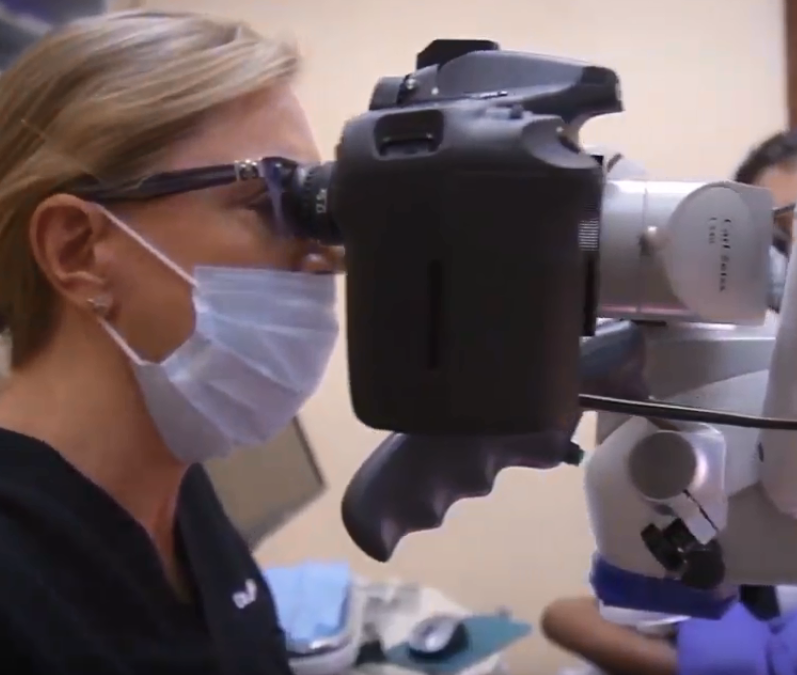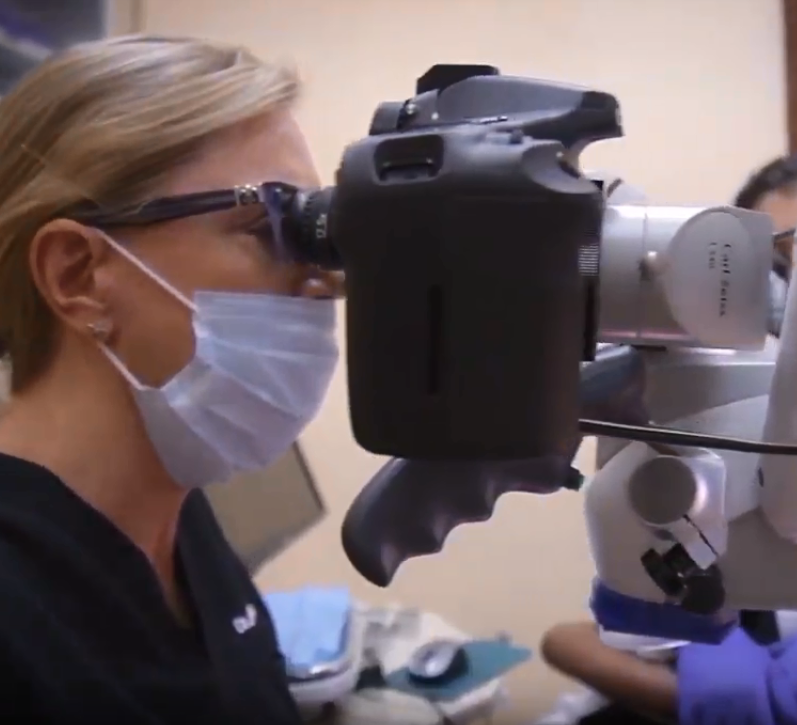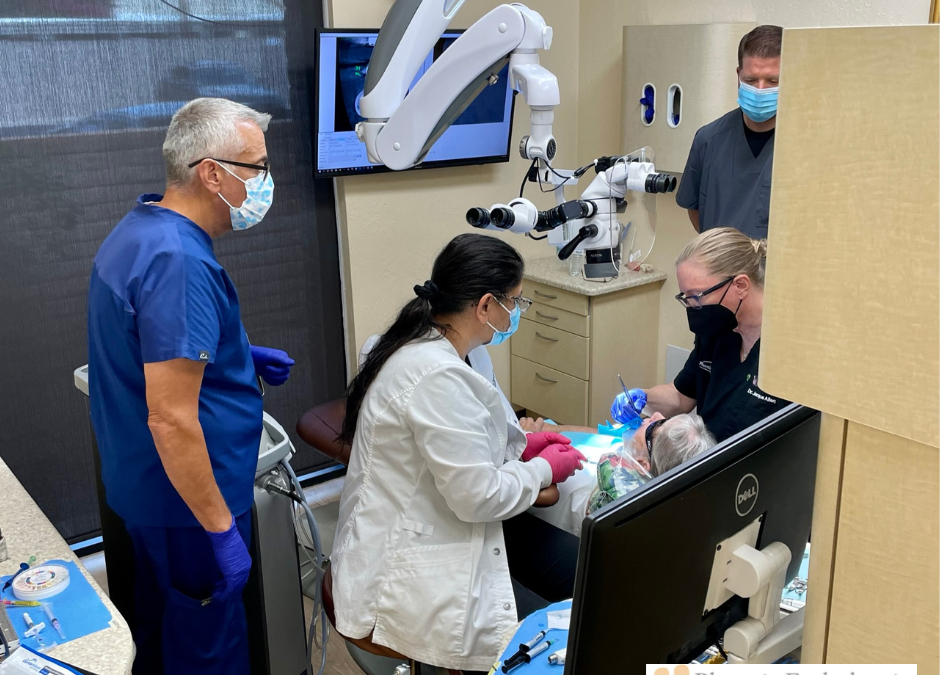
by Dr. Jacqueline S. Allen | Dec 20, 2022 | Blog, Endodontics, Endodontist, Root Canal
More than 41,000 root canal treatments are performed each day in the United States – more than 15 million each year. Threats to your natural teeth leading to a root canal are not complicated, but each person’s experience of their symptoms can be unique.
Let’s look at some of the causes and symptoms of tooth infections that can result in a root canal. If you experience any of these symptoms, contact your dentist or endodontist immediately to schedule an examination.

The Two D’s Of Tooth Root Infection
Root canal treatment has proven to be one of the most effective ways to deal with infection in the pulp of the tooth. The infection is usually related to two major culprits: damage to the tooth structure that lets in bacteria, or advanced decay reaching the interior areas of the tooth. Such an infection might show in a variety of symptoms.
Symptoms Indicating A Root Canal Is Needed
1. Persistent pain in a tooth. A healthy tooth does not hurt. While tooth pain can require other treatments beyond or in addition to a root canal, constant or recurring tooth pain should definitely prompt a visit to your dental provider.
2. A pimple or “gum boil” near the infected tooth. Dying tissues in the tooth can cause a buildup of fluid under the gum surface. If the boil bursts, the fluid will have an unpleasant taste and odor.
3. Swollen gums near the infected tooth. Your gums may feel tender or look swollen, even if there is no gum boil present. This swelling can be intermittent, so you may not be in the clear even if the swelling goes away for a while.
4. Sensitivity to sources of heat and cold. An infected tooth can feel pain or sensitivity to hot or cold food and drink, even long after you’ve consumed it. The sensation can be anything from a sharp pain to a dull ache.
5. Your tooth feels loose when you touch it. The tooth infection can seep acidic wastes that soften the bone around the tooth needing a root canal, making it feel loose inside your mouth.
6. The tooth is discolored. The roots of a badly infected tooth may be receiving a poor supply of blood, which can make it look darker than usual.
Clearly, it’s difficult to know if you need a root canal without a thorough dental examination. If you have one or more of these symptoms, make an appointment now to get an official diagnosis.
“Symptoms of dental issues requiring a root canal can be highly individualized,” says Dr. Jacqueline Allen, Phoenix Endodontic Group. “Our endodontists will evaluate your symptoms and plan your treatment so you can save your tooth and stop hurting.”

by Dr. Jacqueline S. Allen | Nov 21, 2022 | Blog, Endodontics, Endodontist, Phoenix Endodontic Group, Root Canal
It can be a shock to learn you require root canal therapy to address an injured or infected tooth. If you’ve never been to an endodontist, or don’t have any friends or family who’ve had a root canal, you may naturally have a lot of questions about what to expect.
Understanding the details of root canal therapy can help you come to your first appointment better prepared. Here is a brief overview of the main stages of a root canal.
 The Key Stages Of Root Canal Therapy
The Key Stages Of Root Canal Therapy
-
Confirmation of diagnosis. Your endodontist will confirm your diagnosis when you arrive for your first root canal therapy appointment by reviewing your X-rays and performing a visual inspection of your tooth.
-
Local anesthesia and dental dam placement. The endodontist will numb the area around your tooth with a local anesthetic. They will also place a rubber sheet known as a dental dam around the tooth to keep it clean and dry while they work.
-
Creating an access hole. After the tooth has been prepared and your gums numbed, an access hole will be drilled in the crown of the tooth to allow the dental pulp to be removed.
-
Pulp removal, filing, and cleaning. Once the access hole is created, the endodontist removes the infected tooth pulp, using special instruments to reshape the tooth’s canals and ensure all infected material is gone. Then the inner tooth is treated with antimicrobial washes to remove debris and aid healing.
-
Filling the root canals. This is the step that gives root canal therapy its name. A biocompatible material, usually gutta-percha, is used to fill the canals and prevent future infections.
-
Placement of temporary filling. The first part of the root canal procedure concludes with a temporary filling on your tooth to ensure the tooth heals and bacteria is not re-introduced while your permanent restoration is being fabricated.
-
Placement of permanent filling and crown. Your root canal therapy is not considered complete until a permanent filling is placed on your tooth, AND the tooth is capped with a crown. A crown provides extra protection against infection and shores up the structural integrity of your natural tooth.
“Patients are surprised sometimes to find out that root canal therapy follows a simple, straightforward process,” says Dr. Jacqueline S. Allen, who practices at Phoenix Endodontic Group. “But our profession’s approach to this procedure has been developed and refined for more than 150 years. We’re happy to explain each step in detail, and to address any concerns or questions you may have, every step of the way. We want each of our patients to be comfortable and confident.”
by Dr. Jacqueline S. Allen | Oct 21, 2022 | Blog, Endodontics, Endodontist, Root Canal, Vital Pulp Therapy (VPT)
While endodontists excel at performing root canal therapy on teeth compromised by injury or infection, they also have other effective techniques for saving natural teeth. One procedure that can provide excellent results is vital pulp therapy, or VPT. Once considered something that could only be performed on younger patients with still-developing adult teeth, today VPT has been proven even more broadly effective when patients meet a select set of circumstances related to the state of their pulp — the mass of blood vessels, nerves and connective tissues that represent the living center of a tooth.
How Vital Pulp Therapy Works To Preserve Natural Teeth
There are three main versions of VPT. Endodontists determine which one has the greatest chance of success by a careful examination of a patient’s tooth and of the decay or infection present in the pulp.
-
Direct capping of the pulp is most often used in immature adult teeth or in teeth that do not show evidence of irreversible pulp inflammation. This approach calls for the removal of all the infected pulp, followed by irrigation of the affected area with a solution of 17 percent ethylenediaminetetraacetic acid (EDTA). Once the area from which the pulp was removed has been capped with a bioceramic material, the healing can begin.
-
Indirect capping is a technique that is similar to direct capping, but in this case, some or all of the infected pulp is left in place to avoid direct exposure of the pulp during examination or the capping process itself. A cap is placed over the infected pulp to stop the infection from spreading and to promote reparative dentin development in the tooth.
-
Pulpotomies are yet another type of vital pulp therapy. They are performed by removal of infected pulp down to healthy coronal tissue, or even into the canals of the tooth if necessary. Medicines may be applied to address the inflammation and the infection. As with the previous two treatments, the area is capped with a biocompatible ceramic restoration. A light-cured glass ionomer may be added above the cap to ensure the solution for saving the tooth is permanent and leak proof.
“Vital pulp therapy offers another opportunity for endodontists to preserve natural teeth — in some cases, the pulp itself can be preserved,” says Dr. Allen, who practices with the Phoenix Endodontic Group. “Our specialty is constantly evaluating therapeutic techniques like VPT for their efficacy in saving teeth over the long term.”

by Dr. Jacqueline S. Allen | Sep 27, 2022 | Blog, Business, GentalWave, Root Canal

Through Innovative Technology, Phoenix Endodontic Group to Provide Patients with a Simpler and Less Invasive Option for Root Canal Therapy
Phoenix Endodontic Group, a leading endodontic practice in Phoenix, AZ., announced today its partnership with Sonendo, Inc., a leading dental technology company, to offer the revolutionary GentleWave® System with CleanFlow™ Technology, a less invasive and less painful alternative to traditional root canal therapy.
The GentleWave Procedure has redefined standard root canal treatment with a minimally invasive process that preserves tooth structure and promotes early healing. With a goal to save patients’ natural teeth, the system is designed to treat tooth decay by cleaning and disinfecting the microscopic spaces within teeth without the need to remove tooth structure. And with the addition of the CleanFlow procedure instrument, the GentleWave System now offers an even better patient experience and simpler workflow. According to an ongoing clinical trial sponsored by Sonendo, 99.5% of patients had no pain during a root canal procedure utilizing the GentleWave System with the addition of CleanFlow Technology.
 “We are thrilled to introduce the GentleWave System with CleanFlow Technology into our practice and are confident that this marks an important milestone in the transformation of traditional root canal treatment,” said Dr. Jacqueline Allen. “We wholeheartedly support this trusted technology, which allows our patients to experience less pain and heightened comfort.”
“We are thrilled to introduce the GentleWave System with CleanFlow Technology into our practice and are confident that this marks an important milestone in the transformation of traditional root canal treatment,” said Dr. Jacqueline Allen. “We wholeheartedly support this trusted technology, which allows our patients to experience less pain and heightened comfort.”
The GentleWave System uses advanced fluid dynamics, broad-spectrum acoustic energy and accelerated chemistry to deliver an alternative to conventional root canal therapy – a procedure that is traditionally performed with a series of files used to scrape the inside of the tooth, often causing post-operative pain and discomfort for patients and requiring multiple visits to the doctor. With the GentleWave System, patients experience significantly less pain overall and more than 90% of procedures can be completed in a single visit.
“Our goal is to revolutionize the standard of care for root canal therapy. As more doctors use the GentleWave System, more patients can experience less invasive treatment,” said Joanne Lindberg, Vice President of Sales with Sonendo. “We are thrilled to see Phoenix Endodontic Group remaining at the forefront of embracing innovative technology, thereby enabling an enhanced patient experience and streamlined workflow.”
To book your appointment today, contact the Phoenix office via the website: phoenixendontist.com

by Dr. Jacqueline S. Allen | Sep 21, 2022 | Blog, Dental Implants, Dentistry, Phoenix Endodontic Group
If you have a failing tooth (or teeth), you may be wondering if a dental implant might be a workable solution for you. Implants take the place of your natural teeth. They are anchored to your jawbone, and topped with an artificial tooth. Dental implants have a similar success rate to root canals, when performed by a dentist or endodontist with significant experience doing them. They are not, however, the ideal solution for every patient.
Let’s take a look at some factors to consider before getting a dental implant.

What Important Factors Should I Consider Before Getting A Dental Implant?
-
Are there less invasive options that could save the tooth? In some cases, a tooth that is threatened by infection, decay, or advanced gum disease may be able to be saved. Root canal treatment and periodontal (gum) procedures may be solid alternatives; your dental provider will be able to discuss their potential to help you.
-
Have I discussed my health conditions with my provider? The endodontist or implantologist who performs your dental implant will conduct a thorough examination, and take images of your teeth. They will also ask about your medical history. You should discuss any serious conditions such as diabetes or cardiovascular disease. You should also let your provider know if you’re a heavy smoker or if you’ve had radiation therapy to your head or neck.
-
Will I need additional procedures to prepare for my dental implant? Depending on your individual circumstances, you may need a sinus lift, tooth extraction or removal of parts of your damaged tooth, bone augmentation, gum treatment, or other procedures to prepare for your dental implant. Your provider can explain the need for each procedure and how it fits in your treatment timeline.
-
Will I have to commit to multiple appointments over a number of months to complete the dental implant process? Depending on the approach that your provider recommends, you may need to come to a number of appointments to plan, prepare for, and undergo all the procedures that complete your dental implant. Discuss any scheduling constraints with your dental professional and their staff.
“To ensure that a dental implant is the right approach to improve your oral health, our staff will discuss all relevant factors impacting the process before treatment begins,” says Dr. Jacqueline S. Allen, who practices with the Phoenix Endodontic Group. “This ensures your treatment team has all the information needed to provide excellent treatment. It also gives peace of mind that you are making the right choice.”




 The Key Stages Of Root Canal Therapy
The Key Stages Of Root Canal Therapy

 “We are thrilled to introduce the GentleWave System with CleanFlow Technology into our practice and are confident that this marks an important milestone in the transformation of traditional root canal treatment,” said Dr. Jacqueline Allen. “We wholeheartedly support this trusted technology, which allows our patients to experience less pain and heightened comfort.”
“We are thrilled to introduce the GentleWave System with CleanFlow Technology into our practice and are confident that this marks an important milestone in the transformation of traditional root canal treatment,” said Dr. Jacqueline Allen. “We wholeheartedly support this trusted technology, which allows our patients to experience less pain and heightened comfort.” 
